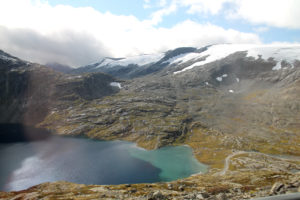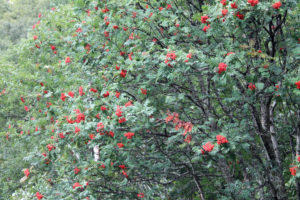Nature’s Best Performance
September 4th, 2018
No wonder Norwegians survey out as the world’s second happiest people. (They were No. 1 in a 2017 Gallup World Poll before the Finns beat them out this year.)
Despite the long, dark, cold winters, it’s hard not to have a joyful heart when you’re surrounded by the natural beauty of Norway.
Words like “awesome” and “majestic” aren’t enough to describe this gem of Scandinavia.
People told me that Norway was the nicest country they had ever visited. Now that I’m back from our latest garden group tour there, I have to agree.
See George’s Photo Gallery of 50 shots from the group tour of Norway, Sweden, and Denmark.
The country’s western fjord region is especially stunning.
Fjords are glacier-cut, deep, narrow waterways that open to the sea and have steep mountains on either side.
The mountains go almost straight up in some spots and are usually blanketed with thick stands of conifers – mostly spruce and pine. The trees seem to grow out of solid rock, defying both botany and gravity.
Green valleys of grasses, moss, and wildflowers grow where water and rock meet. Small villages with picturesque, green-roofed houses pop up here and there throughout the valleys.
Norwegians have long built what they call “summer farms” to take advantage of this excellent grazing land for sheep, goats, and cows.
Birch and rowan trees (a European cousin to our mountain ash that has marble-sized, red fall fruits) also grow in unending masses in the valleys and along roads.
Norway doesn’t have the diversity of tree life that we do, but it makes up for that in sheer quantity.
The most noticeable of Norwegian wildflowers is the fireweed, a rampant-seeding, 2-foot-tall perennial that sends up flower stalks of pink that open from bottom to top as summer progresses.
Norwegians sometimes call it the “calendar plant” because you can tell which month it is by what part of the fireweed flower is blooming.
Waterfalls add natural jewelry to the Norwegian countryside. They run down in narrow bands of sparkling silvery white, often for hundreds of feet before snaking their way into the fjords and lakes below. I’ve never seen so many waterfalls.
Some of the mountains are high enough that they stretch beyond the tree line. These switch to mostly scrubby junipers before turning bare and bald and, when high enough, to white caps of snow and glaciers.
The snow packs and glaciers have been steadily receding for the past 20 years, in case you’re wondering about evidence of a warming climate.
The Norwegians like plants and home gardening, but from what I saw, Mother Nature is by far Norway’s leading landscape designer.
Flowers and vegetables do very well during the May-to-September prime growing season, a time when the days are long, the rain plentiful, and the daytime temperatures mostly in the 70s to low 80s.
This was a year of exception, though, for Norway and most of Europe. The continent went most of June and July without any rain, and Scandinavians sweated out multiple days of unheard-of 90-plus-degree days. This kind of heat is so rare that northern Europeans don’t even have air-conditioning in their buildings.
Many of the plants in Norway showed their distaste for this blast of Texas by browning around the leaf edges and defoliating altogether.
Despite being so far north (Norway stretches into the Arctic Circle), coastal Norway can grow some plants that we can’t.
A case in point is the gunnera, a rhubarb cousin with thick stems and huge leaves the size of house windows. Our winters are too cold to grow this botanical giant, but gunnera plants survive in parts of Norway because of the insulating effects of all its water.
Yes, Norwegians get day after winter day of chilly temperatures in the 20s and 30s, but the Atlantic gulf stream is still influential enough that far north to keep the winter lows well above the root-killing, sub-zero dips we get.
One last thing I noticed about Norway is that the people respect and seem to be taking good care of the country’s natural resources.
They haven’t, for example, killed fjord aquatic life with runoff from farm fields and lawn chemicals.
Like most of Europe and Canada, they’re reluctant to spray their plants with insecticides, herbicides, and fungicides.
And they haven’t cut down all of the trees to clear space for condos, casinos, and fjord-side Wal-marts.
Put Norway on your bucket list if you appreciated nature-made scenery.
It’s not a cheap place to get to or vacation in, but it’s proof that sometimes money really can buy happiness.










